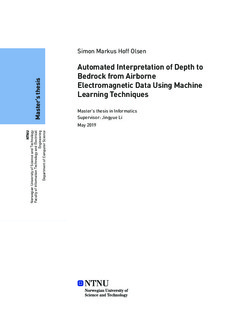| dc.contributor.advisor | Li, Jingyue | |
| dc.contributor.author | Olsen, Simon Markus Hoff | |
| dc.date.accessioned | 2019-09-19T14:04:22Z | |
| dc.date.available | 2019-09-19T14:04:22Z | |
| dc.date.issued | 2019 | |
| dc.identifier.uri | http://hdl.handle.net/11250/2617907 | |
| dc.description.abstract | Tradisjonelle metoder for modellering av berggrunn fra AEM data har tidligere vært avhengig av tidkrevende manuell arbeidskraft. Nye teknikker har introdusert aspekter av automatisering, men det har også presentert nye utfordringer i forbindelse med estimering av usikkerhet fra automatiserte prediksjoner.
Denne oppgaven tar sikte på å forbedre nåværende praksis ved å foreslå en ny teknikk for automatisering, men også ved å vurdere egnetheten til tre forskjellige konstruksjonsteknikker for prediksjonsintervall som usikkerhetsmål.
En case-studie viser hvordan aspekter fra det akademiske feltet om computer-vision kan brukes i sammenheng med mer konvensjonelle maskinlærings teknikker for å forbedre dagens standard. Resultatene fra case-studien viser hvordan tilnærmingen gir reduksjoner i Mean Absolute Error og Mean Squared Error for prediksjoner opp til henholdsvis ~ 50% og ~ 52% sammenlignet med en konvensjonell kunstig nevral nettverk metode.
En egen case-studie viser hvordan ulike konstruksjonsmetoder for prediksjonsintervall passer til forskjellige situasjoner, avhengig av faktorer i det respektive datasettet.
Oppgaven presenterer ny kunnskap i det fortsatt utilstrekkelig utforskede krysningspunktet mellom maskinlæring og elektromagnetiske geotekniske data, og ny kunnskap om muligheten for prediksjonsintervall som et usikkerhetsmål for automatiserte prediksjoner av dybde til berggrunn. | |
| dc.description.abstract | Traditional methods of bedrock modeling from airborne electromagnetic data has previously relied on time-consuming manual labor. Novel techniques has introduced the aspect of automation, but it has also presented a new challenge in uncertainty estimation of the automated results. This thesis aims to further enhance the state of the art, by not only proposing a new technique for automation, but also by evaluating the suitability of three different construction techniques for prediction intervals as an uncertainty measure.
A case study shows how aspects from the academic field of computer vision can be used in conjunction with more conventional machine learning techniques to improve the current standard. The results from the case study shows how the approach brings reductions in Mean Absolute Error and Root Mean Squared Error of bedrock predictions up to ∼ 50% and ∼ 52% respectively, compared to a conventional neural network method.
A separate case study shows how different construction methods for prediction intervals fit different situations depending on factors in the dataset such as the uncertainty distribution.
The thesis presents new knowledge in the still insufficiently explored intersection between machine learning and electromagnetic geotechnical data, and new knowledge in the feasibility of prediction intervals as an uncertainty measure for bedrock depth interpretation. | |
| dc.language | eng | |
| dc.publisher | NTNU | |
| dc.title | Automated Interpretation of Depth to Bedrock from Airborne Electromagnetic Data Using Machine Learning Techniques | |
| dc.type | Master thesis | |
